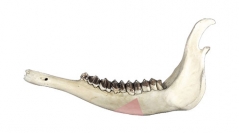

 Comptes Rendus Palevol
17 (4-5) - Pages 320-332
Comptes Rendus Palevol
17 (4-5) - Pages 320-332The early Pleistocene is represented by a succession of glacial–interglacial cycles characterized by a general tendency towards global cooling, with increasing aridity and seasonality. The large deer Eucladoceros is found in abundance in Europe during this period of faunal dispersions. The dietary plasticity of Eucladoceros and how it can mirror early Pleistocene climatic variations will be explored here using Dental Microwear Texture Analysis. The wide range of dental microwear textures for Eucladoceros reflects a low selectivity and high plasticity in its diet. It is an appropriate proxy to track vegetal resource availability. Oscillations were identified between a browsing and a grazing signal. This study proposes that a browsing signal is associated with a fossil assemblage deposited during an interglacial event characterized by warmer temperatures and deciduous vegetation. A grazing signal more likely indicates a glacial event with cooler temperatures and a developed herbaceous, bushy layer.
Dental Microwear Texture Analysis, Villafranchian, Feeding plasticity, Climatic oscillations, Paleoenvironments, Cervidae